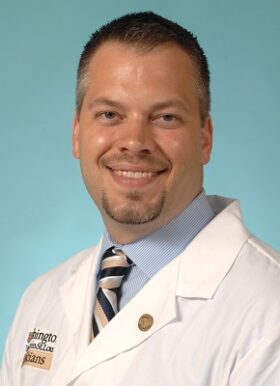
Daniel H. Cooper, MD
Professor of Medicine
Director, Electrophysiology Fellowship
- Phone: 314-362-1291
- Fax: 314-454-8250
Related Links
Education
- BA: Washington University in St. Louis, St. Louis MO (1999)
- Medical School: Loyola University Chicago Stritch School of Medicine, Chicago, IL (2003)
- Residency: Internal Medicine, Barnes-Jewish Hospital, St. Louis, MO (2006)
- Chief Resident: Internal Medicine, Barnes-Jewish Hospital, St. Louis MO (2007)
- Cardiology Fellowship: Cardiology, Washington University School of Medicine, St. Louis, MO (2009)
- Chief Fellow: Cardiology, Washington University School of Medicine, St. Louis, MO (2009)
- Clinical Cardiac Electrophysiology Fellowship: Washington University School of Medicine, St. Louis, MO (2011)
Board Certifications
- Cardiovascular Disease
- Electrophysiology
Recognition
- Knowlton Incentive for Excellence Award, 2008
- Resident of the Year Award, 2006-2007
- Clinical Scientist Training And Research (C-STAR) Program, 2005
- Resident of the Year Award, 2004-2005
Clinical Interests
Diagnosis and treatment of cardiac rhythm disturbances and advanced heart failure. Specialized in treatments that include catheter ablation for SVT, complex ablative therapies for ventricular tachycardia and atrial fibrillation, treatment of advanced heart failure with cardiac resynchronization therapy, and implantation of permanent pacemakers and defibrillators.
Research Interests
My clinical and research interests revolve around the prevention of sudden cardiac death (SCD) and the understanding of the mechanisms that lead to ventricular arrhythmias and cardiac arrest. This includes two distinct groups of patients that can be broadly classified as those with and without structural heart disease.
Patients without structural heart disease would include those with long and short QT, Brugada syndrome, early repolarization syndrome, catecholaminergic polymorphic VT (CPVT) and idiopathic VT/VF. There are inherent difficulties with managing these patients with respect to decisions regarding device implantation, device programming after implant, dealing with inappropriate ICD shocks, genetic counseling, etc. As the largest center in our region, we are uniquely positioned to attract and care for these patients. We are able to offer these patients and families the opportunity to participate in research studies geared at delineating the mechanisms of sudden death in these disorders, utilizing noninvasive imaging modalites, such as ECG imaging (ECGi).
Patients with structural heart disease and depressed LV systolic function are clearly at higher risk for ventricular tachyarrhythmias. The current state of risk stratification and clinical guidelines leans heavily on LV ejection fraction to guide ICD implantation for the primary prevention of SCD. This provides us a large group of patients that are treated similarly despite a clear and growing knowledge base that points to significant heterogeneity in this group with respect to arrhythmic risk. Understanding the differences in myocardial substrate that allows for this difficulty interests me greatly. Specifically, I am interested in efforts to better define any given patient’s individualized risk for ventricular arrhythmias and our ability to use this information to guide decisions regarding ablation strategy, drug therapy, and device programming. Given our fortunate relationships with CBAC and our colleagues in radiology and nuclear medicine, we have the opportunity and resources available to further our understanding of this complex substrate. This will ultimately yield cascading benefits on the clinical side, with development of an approach to VT/VF management that relies heavily on noninvasive imaging prior to the ablation that could conceivably shorten procedure times, limit periprocedural complications and improve outcomes.